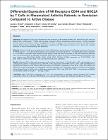| dc.contributor.author | O'FARRELLY, CLIONA | en |
| dc.date.accessioned | 2011-11-29T12:25:26Z | |
| dc.date.available | 2011-11-29T12:25:26Z | |
| dc.date.issued | 2011 | en |
| dc.date.submitted | 2011 | en |
| dc.identifier.citation | Ceara E. Walsh, Elizabeth J. Ryan, Cliona O Farrelly, Lucy Golden-Mason, Oliver FitzGerald, Douglas J. Veale, Barry Bresnihan, Ursula Fearon, Differential Expression of NK Receptors CD94 and NKG2A by T Cells in Rheumatoid Arthritis Patients in Remission Compared to Active Disease, PLoS One, 6, 11, e27182, 2011 | en |
| dc.identifier.other | Y | en |
| dc.identifier.uri | http://hdl.handle.net/2262/61004 | |
| dc.description | PUBLISHED | en |
| dc.description.abstract | Objective:
TNF inhibitors (TNFi) have revolutionised the treatment of rheumatoid arthritis (RA). Natural killer (NK) cells and Natural Killer Cell Receptor+ T (NKT) cells comprise important effector lymphocytes whose activity is tightly regulated through surface NK receptors (NKRs). Dysregulation of NKRs in patients with autoimmune diseases has been shown, however little is known regarding NKRs expression in patients with TNFi-induced remission and in those who maintain remission vs disease flare following TNFi withdrawal.
Methods:
Patients with RA were recruited for this study, (i) RA patients in clinical remission following a minimum of one year of TNFi therapy (n = ?15); (2) Active RA patients, not currently or ever receiving TNFi (n = 18); and healthy control volunteers (n = 15). Patients in remission were divided into two groups: those who were maintained on TNFi and those who withdrew from TNFi and maintained on DMARDS. All patients underwent full clinical assessment. Peripheral blood mononuclear cells were isolated and NKR (CD94, NKG2A, CD161, CD69, CD57, CD158a, CD158b) expression on T-(CD3+CD56?), NK-(CD3?CD56+) and NKT-(CD3+CD56+) cells was determined by flow cytometry.
Results:
Following TNFi withdrawal, percentages and numbers of circulating T cells, NK cells or NKT cell populations were unchanged in patients in remission versus active RA or HCs. Expression of the NKRs CD161, CD57, CD94 and NKG2A was significantly increased on CD3+CD56-T cells from patients in remission compared to active RA (p<0.05). CD3+CD56-T cell expression of CD94 and NKG2A was significantly increased in patients who remained in remission compared with patients whose disease flared (p<0.05), with no differences observed for CD161 and CD57. CD3+CD56? cell expression of NKG2A was inversely related to DAS28 (r = ?0.612, p<0.005).
Conclusion:
High CD94/NKG2A expression by T cells was demonstrated in remission patients following TNFi therapy compared to active RA, while low CD94/NKG2A were associated with disease flare following withdrawal of therapy. | en |
| dc.language.iso | en | en |
| dc.relation.ispartofseries | PLoS One | en |
| dc.relation.ispartofseries | 6 | en |
| dc.relation.ispartofseries | 11, e27182 | en |
| dc.rights | Y | en |
| dc.subject | Immunology | en |
| dc.subject | TNF inhibitors (TNFi) | en |
| dc.title | Differential Expression of NK Receptors CD94 and NKG2A by T Cells in Rheumatoid Arthritis Patients in Remission Compared to Active Disease | en |
| dc.type | Journal Article | en |
| dc.contributor.sponsor | Health Research Board (HRB) | en |
| dc.type.supercollection | scholarly_publications | en |
| dc.type.supercollection | refereed_publications | en |
| dc.identifier.peoplefinderurl | http://people.tcd.ie/ofarrecl | en |
| dc.identifier.rssinternalid | 76072 | en |
| dc.subject.TCDTheme | Immunology, Inflammation & Infection | en |
| dc.identifier.rssuri | http://dx.doi.org/10.1371/journal.pone.0027182 | en |




